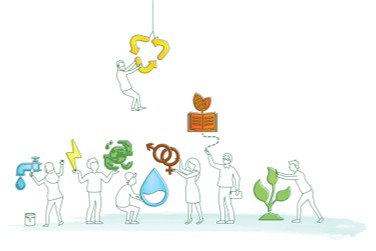Executive Summary
Carbon credits are a tradable commodity that allows an emitter to compensate carbon emissions and are equivalent to 1 ton of carbon dioxide (CO2) or another type of greenhouse gas. Water-related enterprises can obtain carbon credits by monitoring and certifying the positive environmental impact of relevant solutions in terms of CO2 reduction, e.g., through more sustainable wastewater treatment solutions, or providing safe water that allows consumption without prior boiling with charcoal or wood to make water safe for consumption, which is still the standard in many developing countries. The tons of carbon dioxide emissions that have been saved through the use of one intervention will then be sold on the global carbon market, and the buyer – often a large manufacturing company – will be permitted to emit an equivalent amount of carbon dioxide. Carbon credits therefore provide a mechanism that allows enterprises to finance their work by capitalizing on their climate change mitigation impacts.
When is a Carbon Credit a suitable financing option?
Carbon credits support climate change mitigation and allow water-related companies to create an additional source of income when they manage to qualify for and sell carbon credits. The additional income can be used as smart subsidies to cover CapEx, social marketing activities etc., and will sustainably support the viability of a water-related company. Essentially, companies that aren’t able, for logistical reasons, to drastically or completely reduce their carbon dioxide emissions fund your company’s CO2-saving activities in return for the ability to keep emitting greenhouse gases in line with international regulations.
The following (non-comprehensive) characteristics and implications provide you with an overview to analyse the pros and cons for this investment instruments:
| Enterprise Lifecycle | Established companies |
| Amount | Depends on amount of CO2 reduced |
| Pay-back period (Maturity) | Depends on length of intervention |
| Use of funds | Mostly unrestricted, as long as it goes into activities related to the reduction of greenhouse gases |
Source: Based on (Roots of Impact, 2020)
The following table summarises some key characteristics of a Carbon Credit and implications you should consider:
| Characteristics | What does this mean for your enterprise |
| Projects need to be certified to qualify for carbon credits. | Your enterprise needs to acquire the appropriate certifications via the United Nations or an internationally accepted certification body (e.g., Gold Standard). This certification doesn’t come cheap, and can cost several 10k USD, plus regular monitoring expenses. One option to deal with this is to engage with intermediary organizations that certify emission reductions of projects and or enterprises. |
| Expect rigorous monitoring and multiple check-ups. | Carbon credits aren’t based on assumptions, but on meticulous science to assess how much CO2 has really been saved through your project. Everything will be measured, added and subtracted by independent experts, from the amount of wood saved, via the quality of water, all the way to the emissions of your transportation and delivery system. |
| Selling relevant impact of your enterprise. | By selling the emission reductions that you create through your business, you are selling off a key impact you generate through your business. In case you consider raising funds from impact investors, you should take this into consideration. |
| Buyers can sell on unused carbon credits. | Buyers of your carbon credits are permitted to allow an equivalent of the CO2. In case they do not meet this cap, they can sell on used carbon credits, thus creating an additional incentive for them to reduce their emissions (“cap-and-trade”, Investopedia). |
Key features
- Carbon credits are interesting for water-related enterprises that are willing to invest in a rigorous monitoring system and trace their impact on people’s lives and the environment. In the long-term, the sales of carbon credits will help your water-related enterprise to have a steady income stream for subsidizing company activities and/or expansion. Carbon credit-accredited water enterprises also have an advantage in demonstrating a mature level of monitoring to investors. Investors, on the other hand, are assured that a carbon credit-selling company is certified and complies with rigorous monitoring standards.
- To sell carbon credits on the voluntary market, your project needs to be certified by an international certification body, like the Gold Standard or VCS Standard among others. This requires an extensive monitoring process in which an enterprise proofs and quantifies how many tons of CO2 have been reduced by a specific project through the use of water filters, chlorine and other HWTS in comparison to make water safe for drinking through boiling (e.g., on a fire) (SUMMERS ET AL., 2015).
- Carbon credit mechanisms for water in general have been criticized by a number of people (PICKERING ET AL., 2016; STARR, 2011; YEO, 2013). Two main points that are frequently brought up are: Monitoring is not always correct and transparent. Health benefits can be overstated, for instance when filter usage is being used as indicator for health impact, while high usage rates do not necessarily translate into health impacts (YEO, 2013). Also measuring ‘usage’ does not always happen correctly. A second point of criticism is that the amount of ‘avoided’ emissions can be overstated. Many projects are based on the principle of “suppressed demand”, which means that avoided future emissions are the same as reduced current emissions. Critics note that in many cases households don’t actually or would not intend to boil their water in the absence of the project (YEO, 2013; STARR, 2011).
Tips to build your investment case as a young water-related enterprise
Basic requirements
Carbon credit is a financing mechanism that is suitable for advanced enterprises with a solid track record and a proven, convincing business model. Note that there are two different kinds of markets on which you can trade your carbon credits: a voluntary market as well as the official Certified Emissions Reduction (CER) market. The former is less regulated than the latter, which is closely linked with UN initiatives and established financial institutions.
A pre-condition is that your business model contributes to reducing green house gas emissions. There are different business areas around the water and nutrient cycle where this could be the case. These range from conservation efforts, over resource recovery from waste to (waste)water treatment processes, where direct emissions of carbon dioxide (CO2), methane (CH4), and nitrous oxide (N2O) take place and technical solutions can reduce such emissions. Household water treatment technologies provide another technology, that enables end-users to consume drinking water without having to boil it. Aqua Clara is an example of a water-related company, which has leveraged emission reduction through water treatment solutions to access carbon credits as a form of results based financing. Aqua Clara provides communities with affordable, easy-to use filters, so they can access safe water at home without having to boil it. Since ClimateCare first helped Aqua Clara to sell carbon credits from its work in 2014, the company has saved 120,000 tonnes of CO2 and used Carbon Credits to introduce a new, more flexible, faster water filter. To receive these credits, Aqua Clara has to closely monitor their filters throughout Kenya, making sure they continue to function providing sustainable clean water to households.
Leveraging your impact profile to access carbon credits, if…
…your business model and solution are similar to existing certified projects or enterprises.
For reference, you could check existing databases such as (https://www.goldstandard.org/) or screen the portfolios of companies that provide carbon offset services, with a particular focus on using carbon and other results based finance. If a solution similar to yours has previously been accredited, chances are higher that your application will pass as well.
…you have up-and-running operations, sales and an existing customer base.
In order to be able to prove that your solution saves carbon dioxide or other greenhouse gas emissions on a scale that would make it relevant for carbon credit schemes, you already need to have unlocked a certain level of growth. A proven business model is key here: You are already selling your solution to a substantially large group of beneficiaries to tangibly fall within the equation of 1 carbon credit = 1 ton of emissions.
… you are able to prove, and will continue to be able to prove, your CO2 savings to international certification bodies.
The carbon credit market is rigorously regulated and monitored. In order to certify as a carbon credit-producing organisation, an up-front investment is needed to build your portfolio and cover the costs of certification, which can range in the middle-five-digit USD range. Further, you’ll have to submit yourself to at least annual monitoring activities, which are equally also tied to expenses.
… you can make your solution attractive for potential investors on the global carbon credit market.
Similar to “real life” markets, you will be utilising virtual platforms and marketplaces to attract buyers for your solution. With a growing number of organisations becoming carbon credit certified, you will need to take your competition into account and be able to create an attractive portfolio to be able to hold up to the competition.


